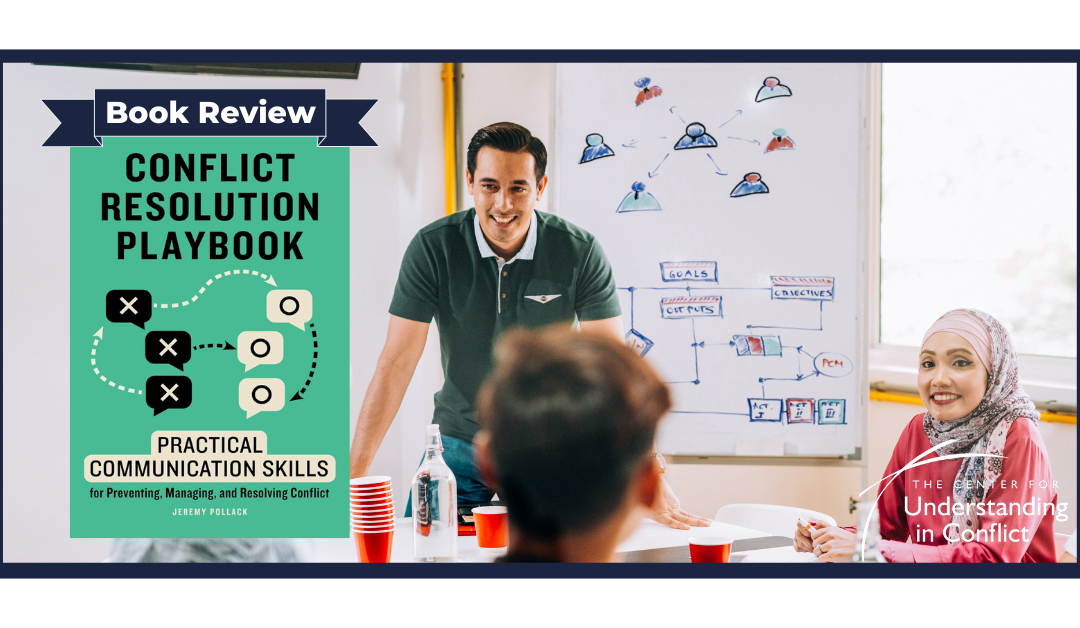In the ever-evolving landscape of interpersonal dynamics, Jeremy Pollack’s “Conflict Resolution Playbook: Practical Communication Skills for Preventing, Managing, and Resolving Conflict” contains insight and guidance for everyone, not just conflict resolution and mediation practitioners. With a pragmatic approach and a wealth of actionable strategies, the author equips readers with the essential tools to navigate the turbulent waters of conflict with finesse and efficacy.
At its core, this playbook serves as a comprehensive manual for both novices and seasoned professionals. It offers a treasure trove of practical wisdom from his extensive field experience. Grounded in the fundamental principles of communication and psychology, Pollack delves into the intricacies of conflict resolution, illuminating the nuanced interplay of emotions, perceptions, and interests that underpin every dispute.
One of the book’s standout features is its accessibility. The author expertly balances theoretical insights with real-world examples, ensuring readers can seamlessly translate theory into practice. Whether grappling with workplace disputes, familial tensions, or interpersonal conflicts, practitioners will find Pollack’s guidance invaluable in navigating diverse scenarios with confidence and poise.
Central to the book’s approach is the emphasis on proactive conflict prevention. Rather than merely reacting to conflicts as they arise, Pollack advocates for a preemptive strategy rooted in effective communication and conflict management skills. By cultivating a culture of open dialogue and mutual respect, practitioners can mitigate potential conflicts before they escalate, fostering harmonious relationships and sustainable resolutions.
Pollack’s work can also serve as a roadmap for effective mediation, offering a structured framework for facilitating constructive dialogue and negotiation. From active listening techniques to reframing perspectives, the Conflict Resolution Playbook equips practitioners with a versatile toolkit to deftly navigate the mediation room. By fostering empathy and understanding, practitioners can empower parties to explore solutions and forge mutually beneficial agreements collaboratively.
One of the book’s most salient strengths lies in its emphasis on the human dimension of conflict resolution. Pollack underscores the importance of empathy and emotional intelligence in bridging divides and fostering reconciliation. Through authentic engagement and genuine rapport-building, practitioners can cultivate trust and cooperation, laying the groundwork for meaningful resolutions. The author also addresses the complexities of power dynamics and cultural differences that often permeate conflict scenarios. By fostering inclusivity and cultural sensitivity, practitioners can navigate diverse perspectives with sensitivity and respect, facilitating a more inclusive and equitable mediation process.
In addition to its substantive insights, Pollack’s playbook offers practical tips and exercises to reinforce key concepts and enhance skill development. Whether honing active listening skills through role-playing exercises or mastering reframing through case studies, practitioners will find ample experiential learning and growth opportunities.
While Pollack’s playbook excels in providing a comprehensive overview of conflict resolution strategies, some readers may find certain sections to be overly prescriptive. While frameworks and guidelines are invaluable, practitioners must also exercise flexibility and adaptability in response to the unique dynamics of each conflict scenario. By embracing a more nuanced and context-sensitive approach, practitioners can more effectively tailor their interventions to meet the specific needs and preferences of the parties involved.
Pollack’s work has the potential to be an indispensable resource for conflict resolution and mediation practitioners seeking to navigate the complexities of conflict with skill and precision. Through its blend of theoretical insights, practical strategies, and experiential exercises, this book equips readers with the tools to foster constructive dialogue, build bridges of understanding, and forge lasting resolutions. Whether grappling with workplace conflicts or familial tensions, everyone can find value in Pollack’s guidance, whether at home, work or in the mediation room.
